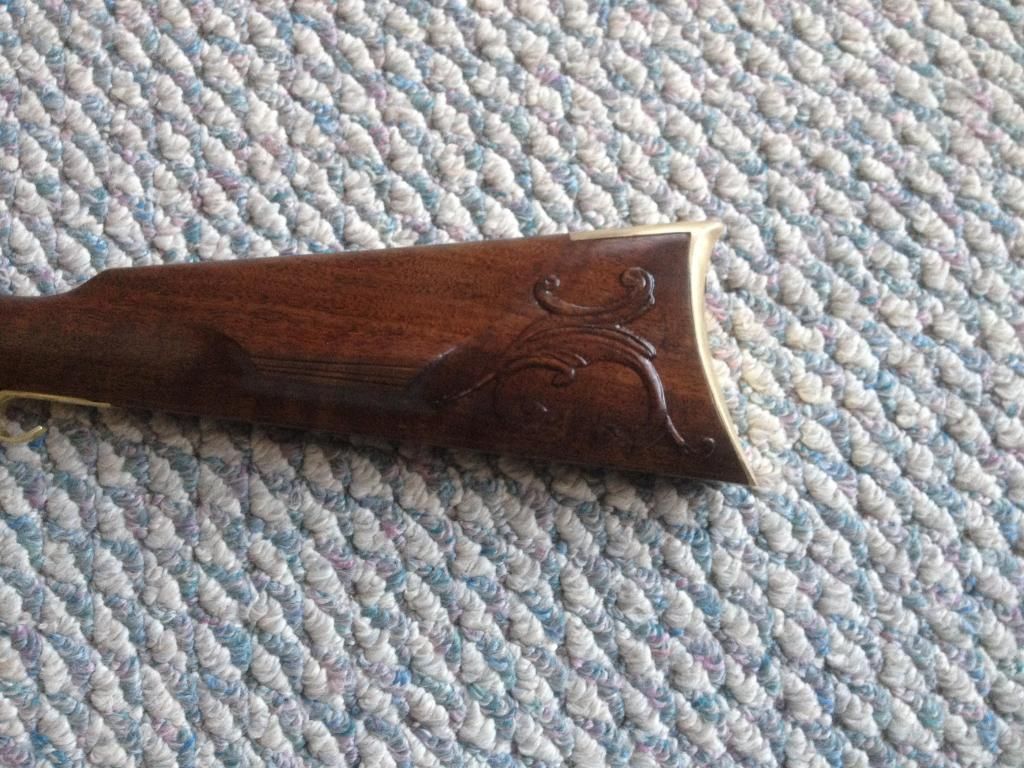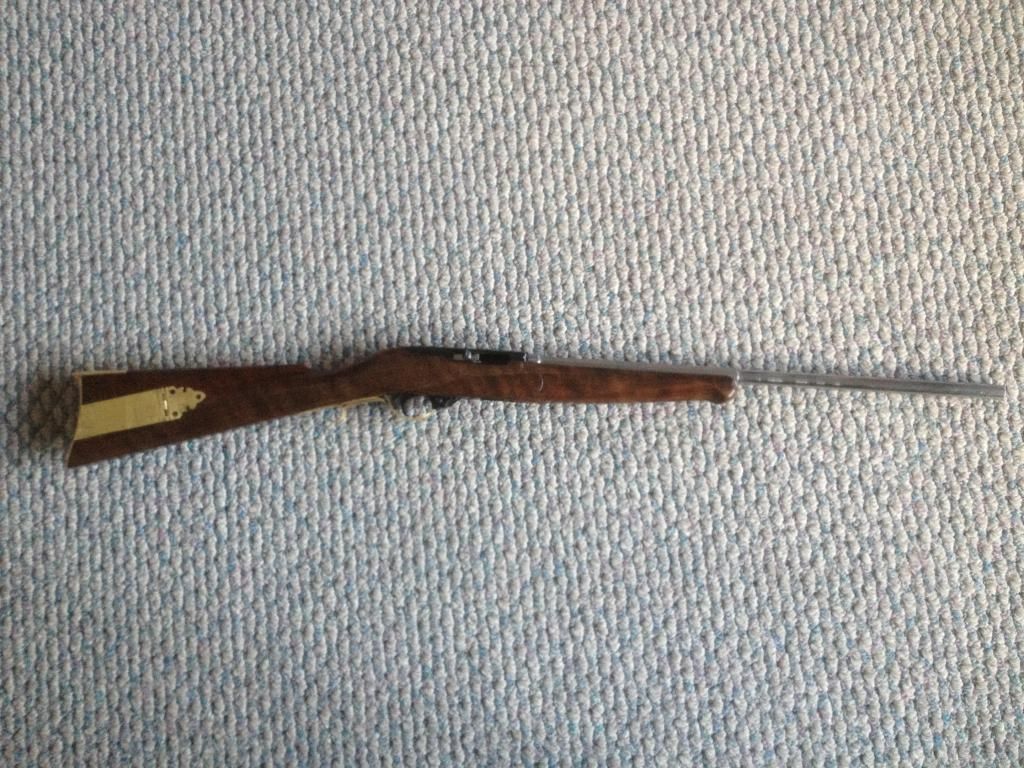You are using an out of date browser. It may not display this or other websites correctly.
You should upgrade or use an alternative browser.
You should upgrade or use an alternative browser.
longrifle type stock
- Thread starter 4V50 Gary
- Start date
trigger643
New member
Wow, that's really really gorgeous. You're obviously very talented. The proportional elements are excellent as well.
Unlicensed Dremel
Moderator
Beautiful. Just beautiful.
Hey Gary, are there jobs in Trinidad? I'm thinking of retraining my career to 'smithing - but I'd have to work full-time while doing it. It's what, 80% latino in Trinidad roughly?
Hey Gary, are there jobs in Trinidad? I'm thinking of retraining my career to 'smithing - but I'd have to work full-time while doing it. It's what, 80% latino in Trinidad roughly?
Unlicensed Dremel
Moderator
Oh ok, thanks. Well, that's out. I can't afford to go live there for 2 years just on savings. I guess online school may be where it's at. Lengua is cow tongue right? That's pretty good stuff.
Living can be cheap and you can buy a house for $20k. Rent can be $500 a month and when shared with other students, even cheaper.
As for not competing against the school, don't expect the law enforcement agencies or the locals to bring their guns to you since they bring it to the school and get it worked on for free. One of our teachers fixed for free an officer's 1911 that wouldn't feed reliably. As a repair project, a classmate fixed an AR that had a canted sight. That's what I mean about competing. The only downside for the customer is that it may take two years before something gets back to you.
During our final exit exam, some of us were given guns that had been sitting around awaiting repairs for two years. Only one gun wasn't fixed and it was not because the student lacked skill but rather the material was potmetal and couldn't be welded on. The student would need a CNC scanner and a CNC mill to make a new part from scratch. He didn't have the time and access to those pieces of equipment (which the school has). He didn't fail though since none of the instructors could have fixed a pot metal piece (except by fabricating new pieces, pinning and JB Welding/gluing the new parts onto the broken one). People have failed the practical exit exam and you could have a 4.0 GPA but if you fail, you receive neither an A.A.S (two year diploma) nor a gunsmithing certificate.
If you want a place to ply your profession, the San Francisco Bay Area lacks gunsmiths but the political climate SUCKS. Australia needs gunsmiths and you can make some big bucks Down Under.
Lengua is cow tongue.
As for not competing against the school, don't expect the law enforcement agencies or the locals to bring their guns to you since they bring it to the school and get it worked on for free. One of our teachers fixed for free an officer's 1911 that wouldn't feed reliably. As a repair project, a classmate fixed an AR that had a canted sight. That's what I mean about competing. The only downside for the customer is that it may take two years before something gets back to you.
During our final exit exam, some of us were given guns that had been sitting around awaiting repairs for two years. Only one gun wasn't fixed and it was not because the student lacked skill but rather the material was potmetal and couldn't be welded on. The student would need a CNC scanner and a CNC mill to make a new part from scratch. He didn't have the time and access to those pieces of equipment (which the school has). He didn't fail though since none of the instructors could have fixed a pot metal piece (except by fabricating new pieces, pinning and JB Welding/gluing the new parts onto the broken one). People have failed the practical exit exam and you could have a 4.0 GPA but if you fail, you receive neither an A.A.S (two year diploma) nor a gunsmithing certificate.
If you want a place to ply your profession, the San Francisco Bay Area lacks gunsmiths but the political climate SUCKS. Australia needs gunsmiths and you can make some big bucks Down Under.
Lengua is cow tongue.
Unlicensed Dremel
Moderator
Very interesting, Gary - thanks.
Jim Watson
New member
There needs to be a course on inspecting guns.
You will not see a thread inquiring about a second hand, inherited, surplus, FoB, or just generally old gun that does not have somebody telling the poor timid OP to get it checked out by a gunsmith.
I just don't know how my generation survived all the surplus sales and used gun racks. We just bought what interested us (or what we could afford), loaded 'em up with what seemed to be suitable ammo, and let fly.
You will not see a thread inquiring about a second hand, inherited, surplus, FoB, or just generally old gun that does not have somebody telling the poor timid OP to get it checked out by a gunsmith.
I just don't know how my generation survived all the surplus sales and used gun racks. We just bought what interested us (or what we could afford), loaded 'em up with what seemed to be suitable ammo, and let fly.
Jim - we get two semesters of firearms repair. We are introduced to the most common guns and how to trouble shoot them. The lessons learned carry over to other firearms. In addition, we are expected to bring in firearms and to service them. Our instructor plays the role of the master gunsmith or customer who expects the firearm to meet industry standard before it leaves the shop. We can replace parts, repair parts, manufacture parts from raw material (I made a hand for a Colt Official Police, a center pin for a Victory Model S&W revolver), make springs, repair stocks and in some cases, refinish the firearm.
For each gun that we are taught about in class, we are expect to disassemble and reassemble them and to take a written test on them (what part does what, if X fails, what are the causes?). Your class grade depends on assembly/disassembly times, test scores and the amount of points earned in servicing firearms.
Last semester I modified three Para-Ordnance 13 round magazines to fit an Izzy polymer frame 1911, repaired a Brown Bess (replica) tumbler so that it would not stop at the half-cock notch, polished the frizzen (it was never polished), refinished a Hawkens replica (after I soldered a rib to the barrel and poured a pewter nosecap), tightened a loose front sight on a S&W revolver, repaired a Browning A-5 that didn't eject (had to make some new parts), repaired a S&W revolver (hammer didn't rotate/trigger locked up - had to make a new part), serviced an Uberti copy of the Colt SAA (clean & lubed it and polished the bushing so the cylinder spun a little better), etc.
A classmate fixed a Trinidad PD's AR-15 rifle that had a canted front sight. It had left the factory that way. Other classmates serviced some 22 rifles for the Boy Scouts. In short, collectively we saw a whole host of firearms being worked on for various reasons. Break open shotguns, single shot rifles, pistols, revolvers, bolt actions (including cracked stocks or stocks that weren't even bedded by the custom maker --- it would have cracked if it had been fired).
By the end of the two semesters of repair, you're supposed to know how to inspect and service a gun. Required (text)books include Numrich Gun Parts Catalog, Brownell's Encyclopedia of Firearms Disassembly, Jack First's catalog (and perhaps a few others which I don't recall). One thing we benefit from are all the videos on YouTube. The classroom has a bunch of NRA Assembly/Disassembly books as well as their Gun Digest counterparts. Students are free to consult with one another too.
For each gun that we are taught about in class, we are expect to disassemble and reassemble them and to take a written test on them (what part does what, if X fails, what are the causes?). Your class grade depends on assembly/disassembly times, test scores and the amount of points earned in servicing firearms.
Last semester I modified three Para-Ordnance 13 round magazines to fit an Izzy polymer frame 1911, repaired a Brown Bess (replica) tumbler so that it would not stop at the half-cock notch, polished the frizzen (it was never polished), refinished a Hawkens replica (after I soldered a rib to the barrel and poured a pewter nosecap), tightened a loose front sight on a S&W revolver, repaired a Browning A-5 that didn't eject (had to make some new parts), repaired a S&W revolver (hammer didn't rotate/trigger locked up - had to make a new part), serviced an Uberti copy of the Colt SAA (clean & lubed it and polished the bushing so the cylinder spun a little better), etc.
A classmate fixed a Trinidad PD's AR-15 rifle that had a canted front sight. It had left the factory that way. Other classmates serviced some 22 rifles for the Boy Scouts. In short, collectively we saw a whole host of firearms being worked on for various reasons. Break open shotguns, single shot rifles, pistols, revolvers, bolt actions (including cracked stocks or stocks that weren't even bedded by the custom maker --- it would have cracked if it had been fired).
By the end of the two semesters of repair, you're supposed to know how to inspect and service a gun. Required (text)books include Numrich Gun Parts Catalog, Brownell's Encyclopedia of Firearms Disassembly, Jack First's catalog (and perhaps a few others which I don't recall). One thing we benefit from are all the videos on YouTube. The classroom has a bunch of NRA Assembly/Disassembly books as well as their Gun Digest counterparts. Students are free to consult with one another too.



